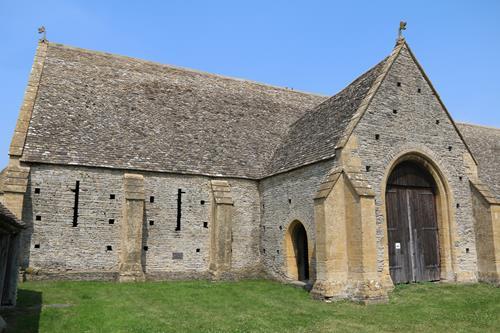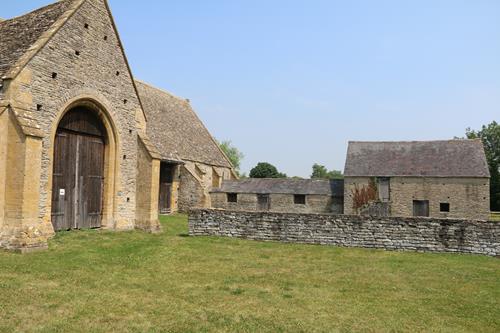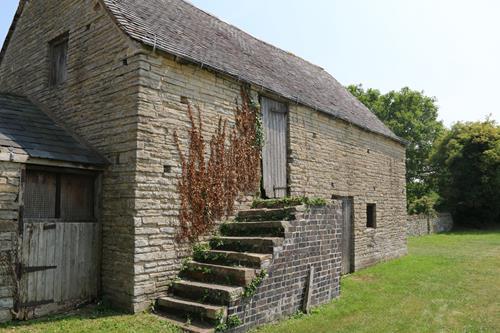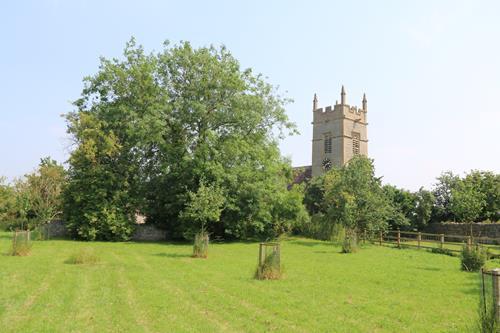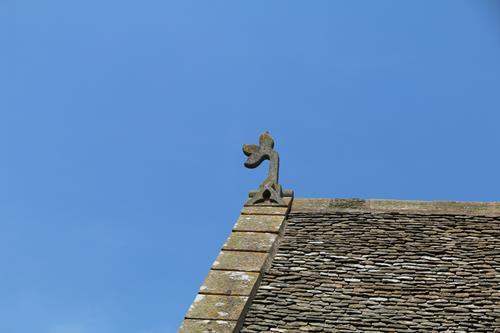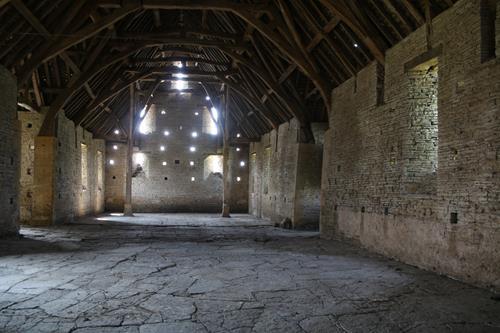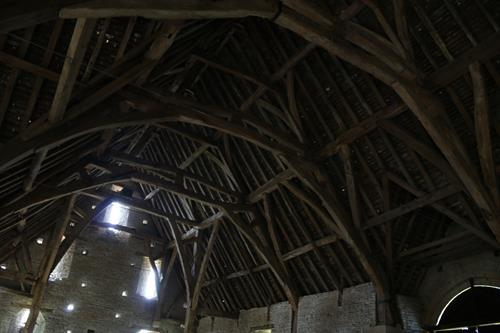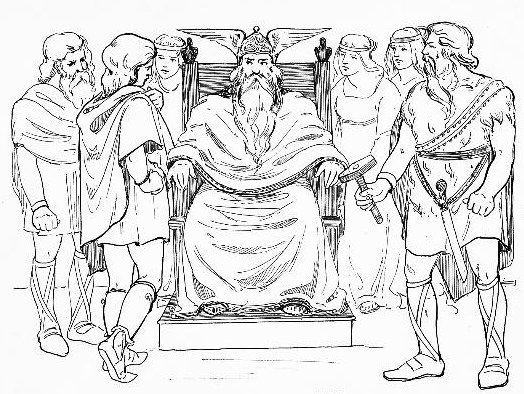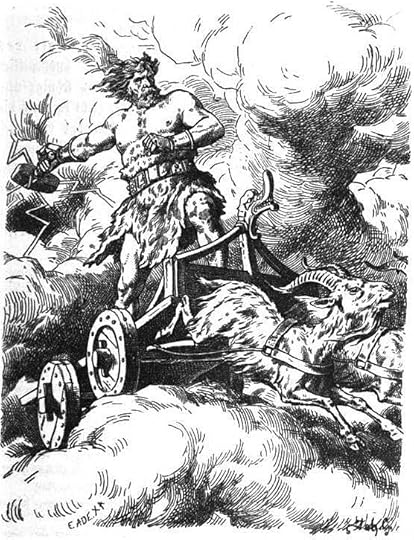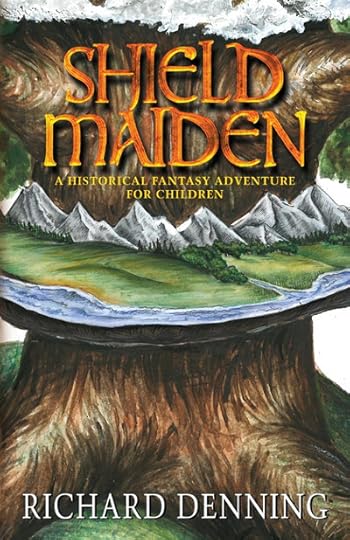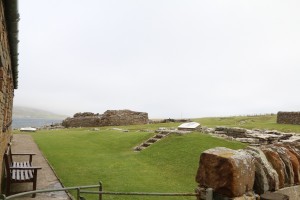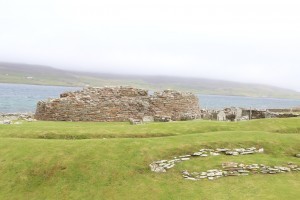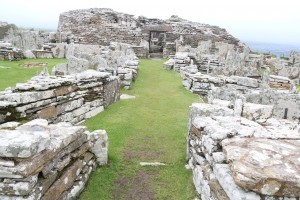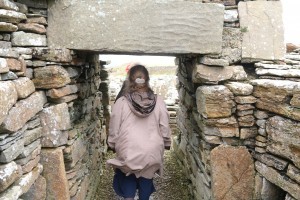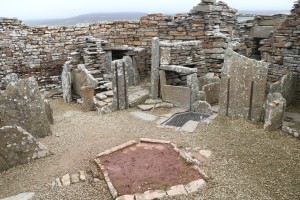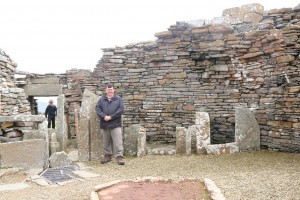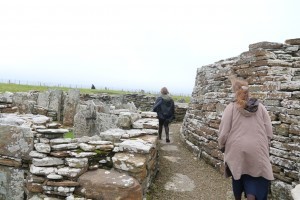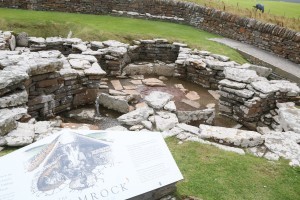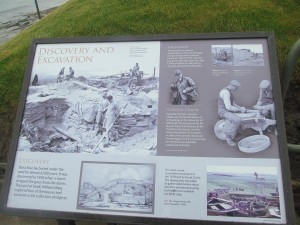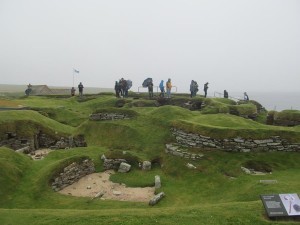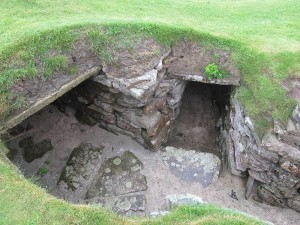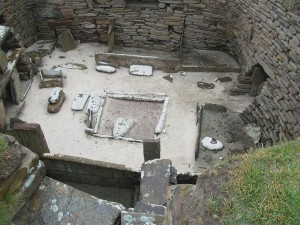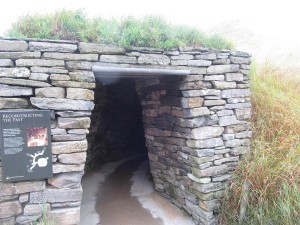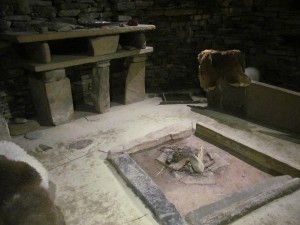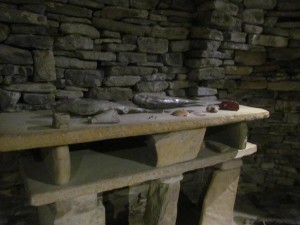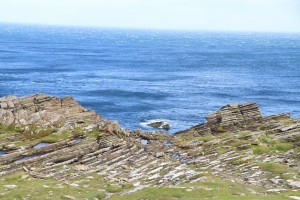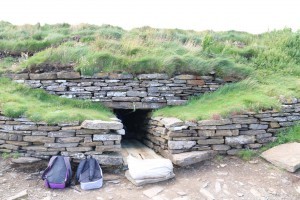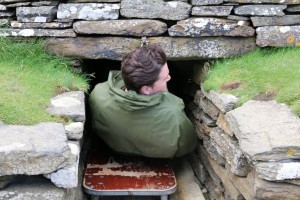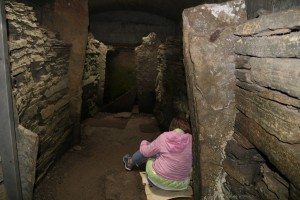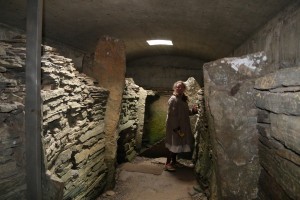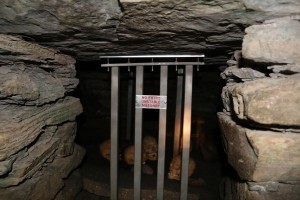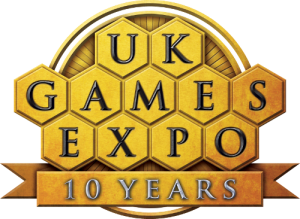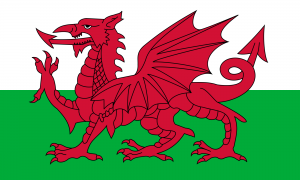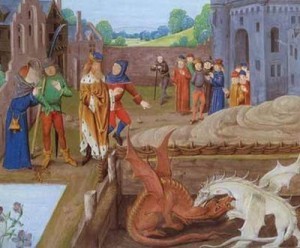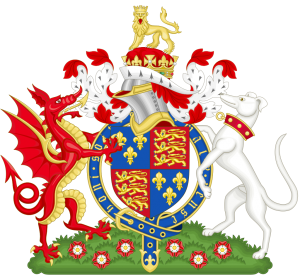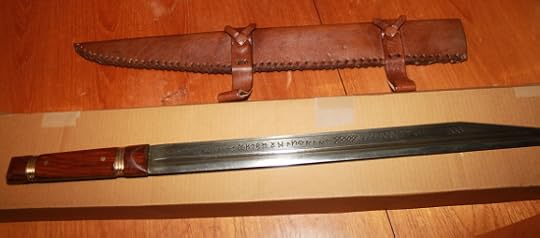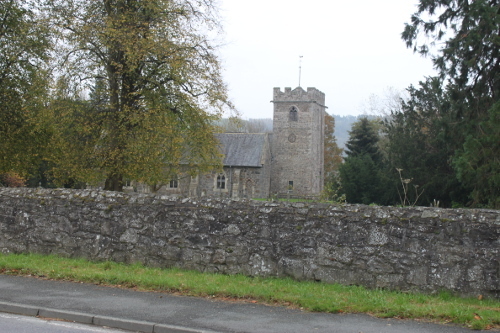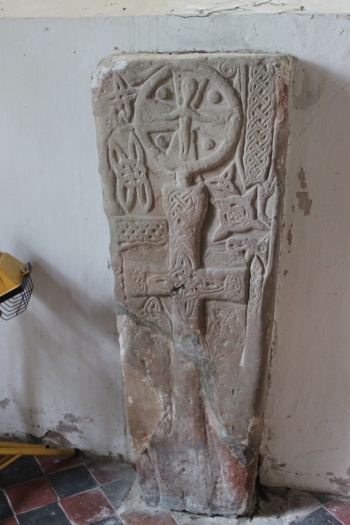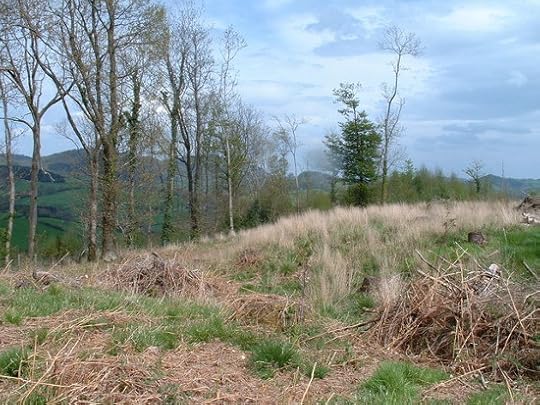Richard Denning's Blog, page 2
July 2, 2017
Kinwarton Dovecote
On a recent trip to Evesham I stopped at this National Trust Property. The Kinwarton Dovecote is a (fairly rare in the UK) surviving circular 14th-century dovecote situated in Kinwarton, near Alcester in Warwickshire. The dovecot is the only remaining structure from a moated grange that belonged to the Abbey of Evesham, which was close by.
The right to own and use a dovecot was a perk of being a Lord of the Manor.
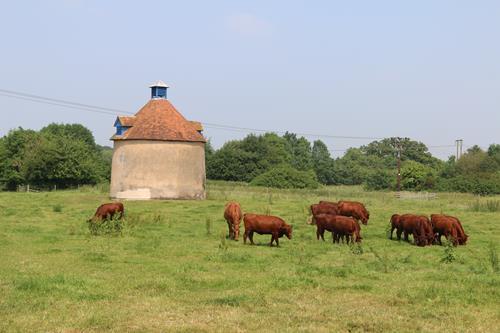
There is evidence of a certain Robert Green gifting a dovecote to Abbot William de Boys of Evesham. There is no specific evidence that this is that dovecot but its the right age so it could well be.
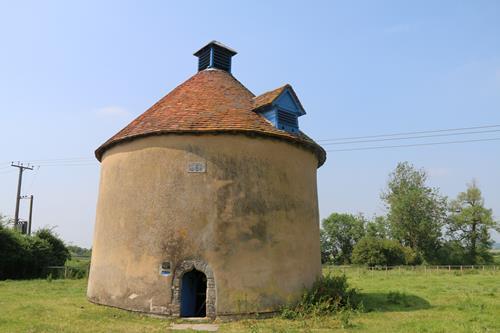
The dating of the dovecot is based on the style of the doorway which is called a ‘ogee’ arch which have a sort of double S shape. The walls which are over 3 feet thick are built of rubble with plaster rendering.
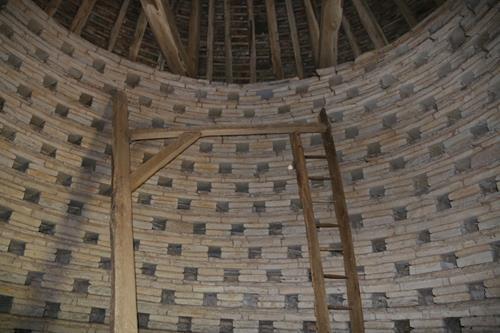
The interior is lined with over 580 nesting boxes arranged in 17 layers. Access to the boxes was made possible due to the installation of a ‘potence’; a ladder which is made to pivot around a central post.
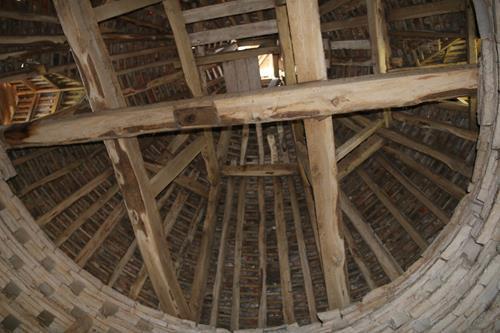
Above you can see the timbered roof and below an idea of the thickness of the walls can be gauged from this shot of the door way from inside the dovecot.
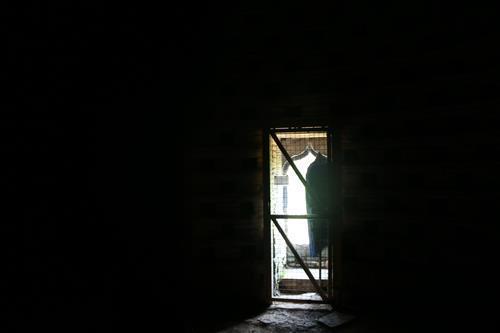
For more information visit the National Trust Site.
[image error]
June 21, 2017
Middle Littleton Tithe Barn
Yesterday I had reason to be driving to Evesham in Worcestershire. having an hour or so to spare I decided to visit Middle Littleton Tithe Barn which is a National Trust Property in a small village near Evesham.
A tithe barn was a type of barn used commonly across most of northern Europe in the Middle Ages for storing rents and tithes. The tithe was paid by the villagers and farmers around a village and represented one tenth of a villagers income or a farm’s produce. As such the bulk of the tithe would be paid in the form of food or drink. The tithe was was given to the Church to help maintain the local church. In exchange the locals received spiritual care, healing and education. Tithe barns were built to store all this produce and was often close to the village church.
One of the largest and finest 13th-century tithe barns in the country is Middle Littleton Tithe Barn. It was once part of a more extensive estate consisting of a Manor House, Church and surrounding farms and fields. It is believed to date to circa 1250.
This out house once housed a cider press and behind it there is still an orchard between the Tithe Barn and the local church.
Upon the roof of the Tithe Barn is a Finial which was not just decorative but believed to keep away evil spirits.
The interior is a huge space. the roof is supported by what is called a raised cruck roof.
Here is another look at the roof structure:
For more on where the Barn is please follow this link…
[image error]
June 14, 2017
Treasures of the Norse and Old English gods.
Today I thought I would take a look at some of the treasures which the Norse and Anglo-Germanic gods were said to owned.
Before the coming of Christianity to the English lands the English shared a common mythology and belief structure to the peoples that would later be called Vikings and the Germanic tribes from which they themselves sprang. They believed in the many gods and goddesses (over 40 possibly) that included Woden (Odin), Thunor (Thor), Heimdall, Freya and Loki.
These god and goddess owned and used marvelous treasures. I take a look at some of them in this article.
Hope you enjoy it.
Megingjörð The megingjörð (the Old Norse words mean “power-belt”) is a belt worn by the god Thor. The Prose Edda lists this as one of Thor’s three main possessions, along with the hammer Mjölnir and the iron gloves Járngreipr. When worn, the belt doubled Thor’s already immense strength.
Mjölnir Mjölnir (the name derived from Old German for “grinder” or “crusher”) is one of the most fearsome weapons, capable of leveling mountains. Snorri Sturluson relates how the hammer was made by the dwarven brothers Eitri and Brokkr. Due to a mishap in its manufacturing it had a characteristically short handle. The pendants and icons of the hammer were a common symbol of the god of thunder in North European mythologies and are found in burials and other locations.
Járngreipr (Old Norse “iron grippers”) are the iron gloves of the god Thor. Thor requires the gloves to handle his powerful hammer. The reason for this may come from the forging of the hammer, when the dwarf working the bellows was bitten in his eye by a gadfly (secretly Loki in disguise) which caused the handle of the hammer to be shortened.
Gungnir Gungnir (Old Norse for “Swaying;”) is the name of the mighty spear that belongs to the god Odin. Images of the god often depicts Odin bearing a spear. Such images date back all the way back to Bronze Age rock carvings of a spear god. As with most of the treasures it was created by the dwarves and had runes carved on its point. The real historical Norse and other Germanic peoples did in fact carve runes into some of their spears, presumably to call upon the same powers that made this weapon so fearsome.
Gjallarhorn Gjallarhorn (Old Norse for “yelling horn”) is a horn associated with the god Heimdall. Its use is mentioned three times in the Poetic Edda. Heimdall uses the horn to drink from Mímir’s well at the root of Yggdrasil and gains much wisdom. Elsewhere it is said that that Heimdall is the owner of the “trumpet” and that “its blast can be heard in all worlds”. Finally it is foretold that in Ragnarök, Heimdall will blow into Gjallarhorn and the the gods will assemble. A figure holding a large horn to his lips appears on a stone cross from the Isle of Man. Gosforth Cross in Cumbria, England depicts a figure holding a horn and a sword standing in front of two beasts.Both of these figures has been theorized as depicting Heimdall with Gjallarhorn.
Draupnir Draupnir (Old Norse for “the dripper”) is a gold ring made by the dwarves for Odin. It has the ability to multiply itself so that every ninth night, eight new rings ‘drip’ from Draupnir, Odin laid the ring on the funeral pyre of his son Baldur.
Brísingamen Brísingamen (It might mean Fire Necklace or Amber Necklace) is the necklace of the goddess Freya. At one point Thor borrows Brísingamen when he dresses up as Freya to infiltrate a wedding in Jotunheim. On another occasion Loki steals the necklace and is pursued by Heimdall. The necklace is also possibly mentioned in the Old English Beowulf saga: Hama bore off to the shining city the Brosings’ necklace.
Helskór Not themselves a god’s treasures although clearly having powers, Helskór ( which means “hel-shoes”) were given to the dead so that they could walk to Valhalla. In one saga these shoes are hanging from a large and beautiful linden-tree. Only travelers that had exercised mercy during their lives were given these. The significance became apparent to the dead because after they had passed this tree they had to cross a heath two miles wide in which thorns grew. This was followed by a river full of irons with sharp edges. Whilst the just could use the shoes to avoid theses perils those deemed unjust suffered immensely.
Dive into a Anglo-Saxon world where the gods are real
The Nine Worlds series is a Historical Fantasy Adventure for Ages 9+. The historical world of Anglo-Saxon England meets the mysterious world of myths and legends, gods and monsters our ancestors believed in.
This is the world as it might have been had those stories been true…
The first e-book is available free on many e-book sites. For example: Amazon.co.uk Amazon.com
[image error]
January 15, 2017
More Images from Orkney: The Broch of Gurness
Hope you are well.
Thought I would share some more images from my summer 2016 trip to the Orkneys. My recent posts have focused on the stone age sites on Orkney. Today I change the era and take a look at The Broch of Gurness.
The Broch of Gurness is an Iron Age broch village on the northwest coast of Mainland Orkney. It is thought to have been inhabited for perhaps 3 or 4 or centuries from about 200 BC onwards.
Come explore the place with me.
Hope you enjoy the images.
Richard
Brochs
The word Broch is a Scots term meaning fort. They are a peculiarly Scottish structure and found pretty much no where else. They are stone round houses from the Iron Age circa 500 BC to 250 AD. The distribution of brochs is centered on northern Scotland with a predominance in Caithness and the Isles.
The Broch of Gurness is thought to have been built circa 200 to 50 BC. 1st century Roman pottery has been found there. Curiously there is a historical reference to contact between a King of Orkney and Emperor Claudius. Could that king have once lived here?
The site was used for several centuries until eventually the central fort was abandoned and in time the site was merely a farm by the 8th century and later a burial site.
Central Fort
The iconic feature of a broch is the central stone roundhouse. This has hollow walls usually in which are built stairs to a higher level. A wooden floor above ground level would have allowed for more accommodation – bed rooms etc.
The outer part of the fortress (outside the round house) was divided into smaller dwellings, workshops and storage areas.
The broch was approached through a central (defendable) doorway and passage that would be difficult to storm.
Central Chamber
At the heart was a central chamber – a gathering place for the inhabitants with a hearth to warm them on those cold winter nights. Around this are smaller rooms.
Outside the Central Tower
The site is surrounded by three ditches cut to the bedrock and stone ramparts. The site is 45 metres diameter. Within the ramparts are the remains of numerous small stone dwellings, yards and sheds.
There is a small museum on the site with helpful information and even a small quern or hand mill you can try yourself.
Thinking of visiting? Find out more here: Broch of Gurness
[image error]
January 1, 2017
Happy New Year and Skara Brae
I would like to wish you all a Happy New Year. Hoping 2017 is a good year for you.
Thought I would share some more images from my summer 2016 trip to the Orkneys and take a look at Skara Brae.
Skara Brae is the best-preserved Neolithic settlement in Western Europe. This site dates back 5000 years to a time long before Stonehenge or even the Egyptian pyramids were built.
It was once a thriving village and then was lost to history, buried under the sand until a freak storm in 1850 revealed an extraordinary site.
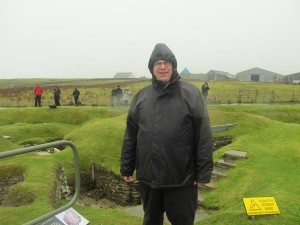
A windy day in Skara Brae
Discovery at Skara Brae
In the winter of 1850, a great storm battered Orkney. The islands are exposed to the fury of the Atlantic on one side and the North Sea on the other. Even in August (when I visited) winds can be high. You can see that is was very wet and windy when we visited this site.
On the occasion of the 1850 storm, the combination of wind and extremely high tides stripped the grass from a large mound to reveal the outline of a number of stone buildings.
The local laird, William Watt, of Skaill, embarked on an excavation of the site in 1868 when the remains of four ancient houses were unearthed. After this, work was abandoned for a generation. Then between 1928 and 1933 more work was done – eventually revealing an entire village.
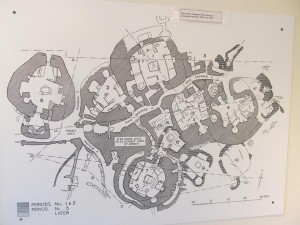
Map of the site.
Dating the Site
In the 1920′s the village was thought to be an Iron Age settlement, dating from around 500BC.
It was radiocarbon dating conducted in the early 70′s that confirmed that the settlement dated from the late Neolithic. It was believed to have been inhabited for around 600 years, between 3100BC and 2500BC.
Chambers and Passages
Skara Brae was fortunate in that due to the protection offered by the sand that covered it for forty centuries, the buildings, and their contents, are incredibly well-preserved.
The site has eight dwellings, linked together by a series of low, covered passages. Many of the walls of the structures and even the roofs were intact.
Each of the eight houses are built to the same basic design. There is a large square room, a central fireplace and beds raised on stone shelves on either side. There is even a stone dresser and food storage pits.
Abandonment
The site was lived in for six centuries. The inhabitants piled up rubbish and refuge in the passage ways and rooms until Skara Brae became embedded in its own garbage. It is also believe that the sand dunes encroached on the site so that around 2500 BC the village was finally abandoned.
Modern Reconstruction
The visitor centre has a nice museum about the site complete with movie, finds and a small reconstruction of part of passageway and one of the houses.
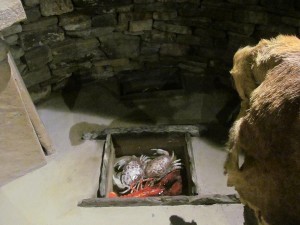
There is even a fridge.
Hope you enjoyed the trip.
Richard
August 23, 2016
Pre-historic Orkney
The Orkneys was home to the Royal Navy which , operating out of its wartime base of Scapa Flow emerged to fight the Battle of Jutland in WW1 and hunt down the Bismarck in WW2 and many other battles. The place is littered with memories of those days: echoes of the days when the British fleet ruled the waves.
But long before the British fleet came to the islands the Orkneys were already ancient with some of the earliest prehistoric sites predating the Pyramids and Stonehenge. Later the Picts bulk their Brochs here and later still the Vikings sailed forth from is harbours.
This is a land and waterways with a deep history and many mysteries. Hope you enjoy the posts I write you about this islands.
The Tomb of The Eagles
At the far south tip of South Ronaldsay is a windswept coastline of cliffs and grasslands dotted with farms. One one of this in 1958, farmer Ronald Simison was digging flagstones and came across the barrow – half buried under the grass. He initially conducted his own excavations but later the archaeologist John Hedges mounted a full study and named the place the tomb of the Eagles.
The tomb was dated to 3000BC. 16,000 human bones were found but also hundreds from the white-tailed sea eagle – hence the name. The eagles died c. 2450–2050 BC, up to 1,000 years after the building of the tomb.
The opening to the tomb is a low tunnel. To gain entry you must lie down on a skateboard like device and haul yourself in.
Once inside the roof is quite high so you can stand up.
There is one main chamber and a number of side chambers.
In one side chamber are skulls – but there are not original inhabitants. They have been placed to give an ideas of what the place looked like, full of bones. Maybe the bodies were left out to decay or for the eagles to feast off and then the bare bones taken into the tomb.
Hope you enjoyed that. More sites to come soon.
[image error]
November 7, 2015
10 Years of Everything about Games
10 Years of Everything about Games
UK’s Largest Hobby Games Convention Proves Tabletop Games are alive and kicking!
Fifteen years in to the twenty second century, with computer and console games massively popular, one could be forgiven for believing that tabletop games have gone the way of the dodo. If you were to make that assumption you would be very wrong. Boardgames, card games, wargames and roleplaying games are not only surviving, they are thriving. Indeed this could well be the Golden Age of Tabletop Games.
Around the world, board game cafés are opening and thriving in Oxford, Valencia and New York as the public rush to tuck a game or two into their lunch hour. Games are becoming better quality each year with amazing components, stunning artwork and engaging play. Conventions are growing year on year and Britain is no exception.
The UK’s largest hobby games convention was only launched in 2007 and is fast approaching its 10th event on 3rd to 5th June 2016. In that time its attendance has expanded from 800 individuals to over7000 and a footfall of 14,000 over the three days. The organisers expect between 8000 and 10000 individuals in 2016 and over 15,000 footfall.
This expansion has meant that for the 2016 convention, the trade hall is being moved into 8000 sqm+ of Hall One of the National Exhibition Centre, whilst maintaining many tournaments and evening events in the nearby Hilton Metropole, one of the biggest convention hotels in the UK.
This event has become the focal point for Hobby Games in the UK. Games companies release new games and demonstrate their prototypes. Some of the largest tournaments in the Hobby Games World occur such as the Catan UK Final, the Carcasonne UK Final and a huge Xwing Miniatures Event with over 200 participants. UK Games Expo boasts the largest Roleplaying Games schedule in the UK with literally hundreds of games sessions in dozens of games systems over the three days.
The family and general visitor is well catered for with dedicated areas showing all the best and newest games both for the family audience and adults too, complete with demonstrators who explain all the rules – no need to work through a complex rule book here. Cosplayers who turn up as characters from Doctor Who, Star Wars and many other films and TV series, live entertainment games with active audience participation and Ambassadors who actively guide you through the show to areas and events suitable for you, all help to make this event easy, safe and above all fun for the family audience.
The UK Games Expo Organisers hereby send you an invitation to be part of their 10th Birthday party.
Dates for the 2016 Show: 3rd to 5th June.
Location: NEC Hall 1 and NEC Hilton Hotel. www.UKGamesExpo.co.uk
[image error]
March 1, 2015
Once and Future King -Origins of the Welsh Dragon
Today is March 1st. It is St David’s Day as well as the national day of wales for whom Davis is their patron saint. On such a day as well as other days of pride in Wales (such as yesterday when the Welsh beat France 20-13 in the Six Nations Rugby Tournament) the Welsh flag is prominent. It is a striking colourful flag too.
It portrays a red dragon on a green and white background. Indeed the name is Y Ddraig Goch, meaning “The Red Dragon”. In more modern use (by which I mean Tudor times onwards) the flag is based on that used by Henry VII at the Battle of Bosworth Field in 1485. The elements that it incorporates are the Red Dragon of Cadwaladr, King of Gwynedd, along with the Tudor colours of green and white. After Henry’s victory it was then included in the Tudor royal arms. Oddly it took until 1959 for the flag to be officially recognised.
So the Red Dragon was used by the Kings of Gwynedd – but there is more history yet to uncover and more significance to the tale.
The reference to the the dragon being used to represent Wales is in the Historia Brittonum, written by Nennius around 830. In this there is the tale of a struggle between two serpents deep underground. These legends later appeared in the ancient book of Welsh tales and stories, the Mabinogion and also in Geoffrey of Monmouth’s Historia Regum Britanniae, where he states a prophecy made by the wizard Myrddin (or Merlin). According to the prophecy, the white dragon, represents the Saxons and the Red the Welsh (or Britons). The White – so the tale went – would first dominate but eventually the red dragon would be victorious .
This legend is believed to represent the conflict in the 5th and 6th centuries between the Britons and the invading Saxons. It seems likely that by the time of Nennius the dragon was established as a symbol of the Romano-British. This is evidenced in Welsh poetry referring to who Cadwaladr king of Gwynedd from c.655 to 682. Some of that poetry foretold that Cadwaladr would rise triumphant over the Saxons – over the English. Hold on to that thought a moment, I will come back to it.
Digging even further back into myths and legends and half remembered history we have to remember that the semi-legendary King Arthur is callled ‘Pendragon’ – or son of the Dragon and it is thought may have used a dragon as a standard. Arthur of course was believed to one day return and this same ‘once and future king’ theme was used again for Cadwaladr.
Now it is been suggested that the Dragons of Arthur and Cadwaladr were possibly based on the standards carried by Roman cavalry units stationed in Britain. As the Romano-British probably used the remnants of the old Roman Cavalry units in battle this is quite likely.
The White and the Red
So then in the 5th and 6th century the Saxons were invading. In the struggles to keep them out the Welsh, possibly even united under a warlord called Arthur rode to battle under the Red Dragon. Later it became associated with a future King who resisted the English, the 7th century Cadwaladr. A powerful belief that one day the Welsh would triumph over the English and once again dominate Britain evolved, finidng its way into the Arthurian legends that Monmouth helped create.
Then one day in 1485 Henry Tudor, who claimed decent from Cadwaladr use this flag at Bosworth. After the battle it is said that Henry was welcomed at the gates of the city of Worcester with this poem.
Cadwallader’s blood lineally descending,
Long hath be told of such a prince coming.
Wherefore friends, if that I shall not lie,
This same is the fulfiller of the prophesy.
So here we have the 15th century interpretation of the fulfillment of the prophecy of the triumph of the Red Dragon and the return of the ‘Once and future king’, hundreds of years later in the form of Henry. Funny how history works out.
January 4, 2015
My replica Beagnoth Knife
My mother probably thought I was mad when I asked for it but I was delighted with a present my parents bought me this Xmas. It is a replica of the Beagnoth Seax which is in the British Museum.
Here is a picture of it:
The Seax of Beagnoth was found in the river Thames in 1857 and dates to 9th century. Inscribed upon it is a complete 28 character set of the FUTHORC or old English runic alphabet. It also contains a name. This might either be the blades owner or its maker. This is an image of the original:

The Beagnoth Seax in the British Museum
I sometimes do talks at schools and Historical Societies on Life in AD 600 and use many such artefacts to illustrate points. In the case of the Beagnoth Seax I can show my audience some of the evidence for how we know the Anglo-Saxons used the Germanic-Norse style runic alphabet.
Furthermore the Beagnoth Seax is evidence that the Saxons were following traditions for inscribing blades to make them more powerful and invincible. Such an activity is mentioned in the Beowulf Saga:
On its bright gold facings there were also runes
set down in order, engraved, inlaid,
which told for whom the sword was first worked,
its hair-keen edges, twisted gold
scrolled in the hilt, the woven snake-blade.
In pure gold inlay on the sword-guards
there were rune-markings correctly incised.
In Norse poetry of the Edda there are clear instructions about inscribing victory runes on a blade:
Winning-runes learn,if thou longest to win,And the runes on thy sword-hilt write;Some on the furrow,and some on the flat,And twice shalt thou call on Tyr.
What this is saying is to write the runes on the blade and in particular to use the Tyr rune. Tyr is the one handed god of Warriors and courage.
The great thing about being able to show an audience a physical object like a blade is to show that our ancestors did this kind of thing in real life.
Who Beagnoth was we do not know but it is thanks to his seax being dropped in the river Thames that we have this evidence today,
October 30, 2014
Tiny Welsh Village and its 15 minutes of fame
There is a saying that each of us will be famous for fifteen minutes. One of the things about history that fascinates me is the fact that locations can also have their time in the spot light. The countryside is littered with small villages, in some cases still thriving and in other cases abandoned or in ruins and in a few instances lost forever, which burst upon the world stage. They become significant for a brief time and then drift into obscurity.
I visited such a place yesterday when researching The White Chariot, the 4th book in my historical fiction series, The Northern Crown. My day job as a doctor sees the hours and minutes filled with hectic appointments in which any free moments are often stuffed with meetings about some new change. Thus to me a day off of bliss can be had by just driving around, music playing on the car stereo whilst I stop at various villages, ruins or scratches on the landscape. I make notes, ponder my plot and try to think back fourteen centuries.
Meifod is a tiny village in the Welsh county of Powys. Now a days it is a pretty enough place on a minor road running through the hills that surround the beautiful Vyrnwy some miles away. Yet it has an almost forgotten past as both one of the most important religious centres in Wales but also home for five hundred years to the Royal Court of Powys. At these times Powys was one of the most powerful of the Welsh kingdoms. It stretched way out over the Shropshire plains as far as modern day Birmingham and Wolverhampton.
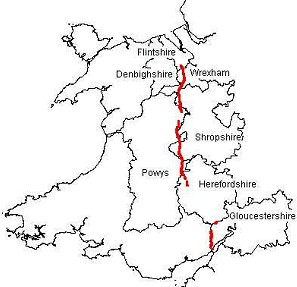
IN the 6th and 7th centuries Powys rules much of modern day Shropshire and Herefordshire.
Meifod is located in the extreme north and eats of modern Powys.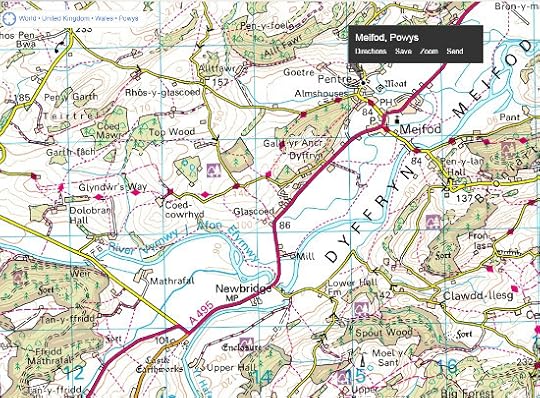
Meifod became a religious centre under a certain Gwyddvarch who built the first church there in the mid to late 6th century. However it became associated with Saint Tyslio after whom the modern church is now named. Prince Tyslio was the second son of Brochfael Ysgythrog King Of Powys. Against his father’s will he went to Abbot Gwyddfarch and begged to become a monk. A Powysian warband was sent to retrieve him, so Tysilio set up his base at a hermitage on Ynys Tysilio (Church Island) near Anglesey in the Menai Straits. After seven years he came back to Meifod and succeeded as Abbot. Tyslio rebuilt the Abbey Church.
After the death of Tysilio’s brother, the Queen Gwenwynwyn,tried to marry Tysilio and place him on the throne of Powys in an attempt to hold on to power. The saint refused so he left and according to legends set up a new monastery in Brittany.
The current church in Meifod is a medieval church and possibly the 4th built there but is located within a hundred yards or so of the site of the original 6th century church.
There is one surviving artifact from the original church. This memorial tomb once marked the spot where a senior noble or prince was once buried and dates to within a century of Tysillo’s time. So you are looking at something that was made some thirteen centuries ago.
The clash between Tysillo and the Queen were not the only association between the area and power. Only a mile or so away to the south west, next to the river is a site known today as “Mathrafal Castle” which there or nearby the court of Powys relocated around 656 at the time of the fall its capital, Pengwern, modern day Shrewsbury in Shropshire. The areas became the focal point then for both political and religious power until Prince Gwenwynwyn ab Owain of Powys relocated his court to Welshpool (Y Trallwng) after Mathrafal it was destroyed during warfare with Gwynedd in 1212. Today all that is left is an earth mound and ditches.
So then – an earth mound and a stone memorial are all that is left from Meifod’s fifteen minutes – more like five centuries of fame.



